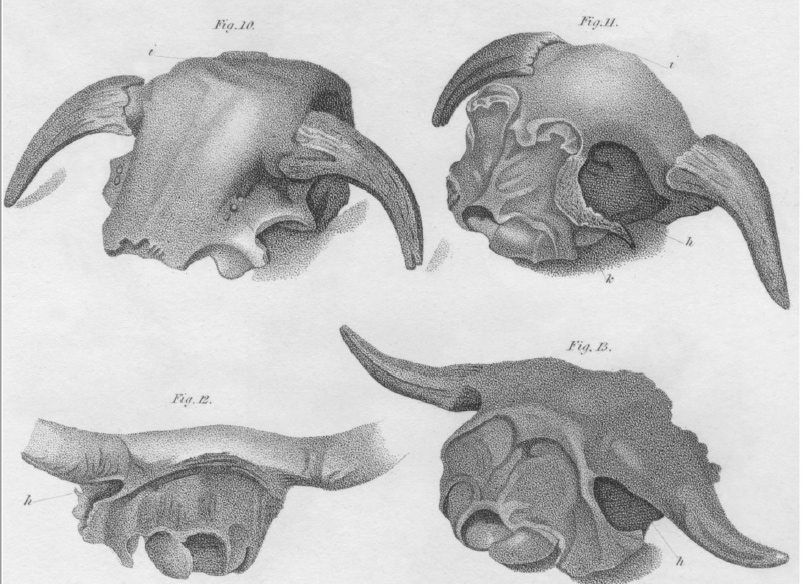Big Bone Lick, KY[1]Because no known record exists of Lewis’s journey between Cincinnati and Big Bone Lick or of his time at the diggings, we can only conjecture that he was at Big Bone Lick on this date. We do … Continue reading Lewis is likely collecting fossil specimens and sending them to the nearest Ohio River landing so that the bones can be shipped to President Thomas Jefferson.
Above: the first two are specimens collected by William Clark at Big Bone Lick in 1807. The bottom row, an ox and buffalo, were used by Caspar Wistar for comparison.
Buffalo Bones
As to the bones found at these places most of those now there are only buffelo bones. This no doubt was there last resort when they were sick; and here they died and left their bones which sunk into the mud.
—Thomas Rodney[2]10 October 1803. Dwight L. Smith and Ray Swick, ed., A Journey Through the West: Thomas Rodney’s 1803 Journal from Delaware to the Mississippi Territory (Athens: Ohio University Press, 1997), … Continue reading
Deep Wells
The main spring at the uper salt works boiled up to the sufface of the ground and fell into the salt wells they had dug around it, which were only 4 or 5 feet deep at the lower works. There was several large wells 10 or 12 feet deep.
—Thomas Rodney[3]Ibid., 113.
Clark’s 1807 Visit
In an 1818 paper addressed to the American Philosophical Society, Caspar Wistar examined two skull types from specimens collected at Big Bone Lick by William Clark in the fall of 1807:
The two heads which are the subjects of the following observations, were selected from a large number of bones presented to the society by our much venerated President Jefferson. Being satisfied that the morass near the falls of Ohio, called the Big Bone Lick, still contained many animal remains which were worthy of attention, he engaged General Wm. Clarke, who is so honourably known to the world by his Journey to the Pacific Ocean, to explore it, and furnished him with all the means necessary for so expensive an undertaking.
Gen. Clarke accomplished the business committed to him with great promptitude, and procured several large boxes of bones.-
By comparing the Big Bone Lick specimens collected by Clark, (see figure, top row) with that of the common ox, Wistar concluded, “Was not this animal nearly allied to the bison?”[4]Mr. Jefferson, and Caspar Wistar. “An Account of Two Heads Found in the Morass, Called the Big Bone Lick, and Presented to the Society, by Mr. Jefferson.” Transactions of the American … Continue reading
Notes
| ↑1 | Because no known record exists of Lewis’s journey between Cincinnati and Big Bone Lick or of his time at the diggings, we can only conjecture that he was at Big Bone Lick on this date. We do know he was in Cincinnati on 3 October 1803 and that he had left Big Bone Lick before Thomas Rodney arrived there on 10 October. |
|---|---|
| ↑2 | 10 October 1803. Dwight L. Smith and Ray Swick, ed., A Journey Through the West: Thomas Rodney’s 1803 Journal from Delaware to the Mississippi Territory (Athens: Ohio University Press, 1997), 112–13. |
| ↑3 | Ibid., 113. |
| ↑4 | Mr. Jefferson, and Caspar Wistar. “An Account of Two Heads Found in the Morass, Called the Big Bone Lick, and Presented to the Society, by Mr. Jefferson.” Transactions of the American Philosophical Society 1 (1818): 375-80. doi:10.2307/1004925. |

